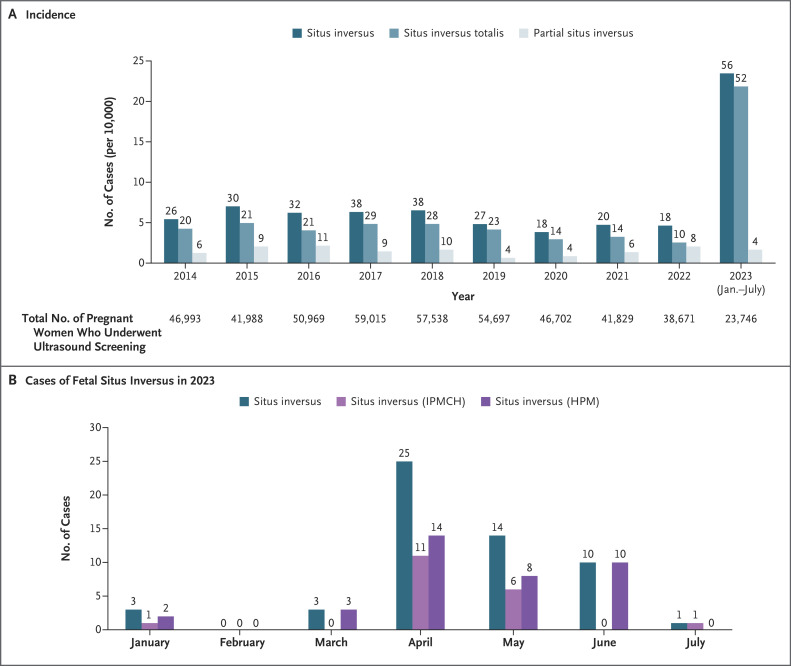To The Editor: Situs inversus, including situs inversus totalis (with dextrocardia) and partial situs inversus (with levocardia), is a rare congenital condition in which visceral organization is inverted as compared with normal organ development. We noted a striking increase in the number of cases of fetal situs inversus that were diagnosed by means of ultrasonography at our hospital several months after the “zero-Covid” policies in China were lifted.
We determined the incidence of fetal situs inversus from January 2014 through July 2023 using clinical data from two obstetrical centers in different regions of China. During the first 7 months of 2023, the incidence of situs inversus (diagnosed by means of routine ultrasonography at a gestational age of approximately 20 to 24 weeks, with no change having been made in the diagnostic protocol or physician training) at these centers was over four times as high as the mean annual incidence from 2014 through 2022 (Figure 1 and Fig. S1 and Table S1 in the Supplementary Appendix, available with the full text of this letter at NEJM.org); the incidence peaked in April 2023 and remained elevated through June 2023. Overall, 56 cases of situs inversus were identified from January 2023 through July 2023 (52 cases of situs inversus totalis and 4 cases of partial situs inversus). The increase followed the surge of severe acute respiratory syndrome coronavirus 2 (SARS-CoV-2) infections that occurred after the zero-Covid policies were discontinued; this surge, which ultimately was estimated to affect approximately 82% of the population in China, began in early December 2022, peaked around December 20, 2022, and ended in early February 2023.1 Although no conclusions can be made regarding causality, our observations suggest a possible relationship between SARS-CoV-2 infection and fetal situs inversus that warrants further study.
Figure 1. Incidence and Case Numbers of Situs Inversus.
Panel A shows the incidence of fetal situs inversus that had been diagnosed at two obstetrical centers from January 2014 through July 2023. The numbers above the bars are the total case numbers by year. Incidence is reported as the number of cases per 10,000 pregnant women who underwent ultrasound screening. Panel B shows the number of fetal situs inversus cases that had been diagnosed at the International Peace Maternity and Child Health Hospital of China Welfare Institute (IPMCH), Shanghai, and the Hunan Provincial Maternal and Child Health Care Hospital (HPM), Changsha, from January 2023 through July 2023.
Congenital situs inversus has been linked to aberrant morphogen distribution and cilia dysfunction of the left–right organizer in visceral lateralization during the early weeks of gestation.2 Although vertical transmission of SARS-CoV-2 is debated,3 fetal infection early in gestation could hypothetically affect visceral lateralization; alternatively, SARS-CoV-2–mediated maternal inflammatory responses4,5 might indirectly affect left–right organizer function and impair visceral lateralization. Further analysis is necessary to verify that genetic abnormalities in primary ciliary dyskinesia–related genes that may not have been detected during prenatal genetic screening did not contribute to the incidence of these cases and to assess the potential contribution of environmental factors. It is notable that situs inversus diagnoses remained extremely rare despite the increase in incidence at our centers after the SARS-CoV-2 surge.
Supplementary Appendix
Disclosure Forms
Footnotes
Supported by grants from the National Key R&D Program of China (2020YFA0112500), the National Nature Science Foundation of China (32271019), the Shanghai Municipal Science and Technology Major Project (20JC1418600), and the Shanghai Jiao Tong University STAR Grant (YG2023ZD26).
Disclosure forms provided by the authors are available with the full text of this letter at NEJM.org.
References
- 1.Fu D, He G, Li H, et al. Effectiveness of COVID-19 vaccination against SARS-CoV-2 omicron variant infection and symptoms — China, December 2022–February 2023. China CDC Wkly 2023;5:369-373. [DOI] [PMC free article] [PubMed] [Google Scholar]
- 2.Nöthe-Menchen T, Wallmeier J, Pennekamp P, et al. Randomization of left-right asymmetry and congenital heart defects: the role of DNAH5 in humans and mice. Circ Genom Precis Med 2019;12(11):e002686-e002686. [DOI] [PMC free article] [PubMed] [Google Scholar]
- 3.Jamieson DJ, Rasmussen SA. An update on COVID-19 and pregnancy. Am J Obstet Gynecol 2022;226:177-186. [DOI] [PMC free article] [PubMed] [Google Scholar]
- 4.Knuesel I, Chicha L, Britschgi M, et al. Maternal immune activation and abnormal brain development across CNS disorders. Nat Rev Neurol 2014;10:643-660. [DOI] [PubMed] [Google Scholar]
- 5.Coler B, Adams Waldorf K. Maternal COVID-19 leaves a lasting immunological impression on the fetus. Nat Immunol 2021;22:1472-1473. [DOI] [PubMed] [Google Scholar]
Associated Data
This section collects any data citations, data availability statements, or supplementary materials included in this article.



